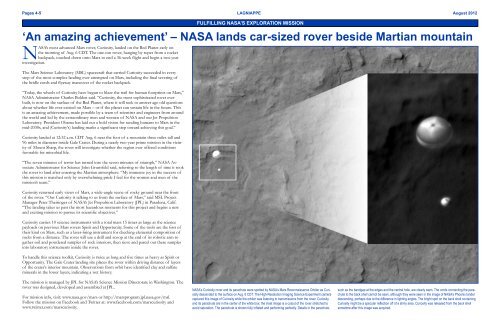Create successful ePaper yourself
Turn your PDF publications into a flip-book with our unique Google optimized e-Paper software.
Pages 4-5 LAGNIAPPE August 2012<br />
<strong>NASA</strong>’s most advanced Mars rover, Curiosity, landed on the Red Planet early on<br />
the morning of Aug. 6 CDT. The one-ton rover, hanging by ropes from a rocket<br />
backpack, touched down onto Mars to end a 36-week flight and begin a two-year<br />
investigation.<br />
The Mars Science Laboratory (MSL) spacecraft that carried Curiosity succeeded in every<br />
step of the most complex landing ever attempted on Mars, including the final severing of<br />
the bridle cords and flyaway maneuver of the rocket backpack.<br />
“Today, the wheels of Curiosity have begun to blaze the trail for human footprints on Mars,”<br />
<strong>NASA</strong> Administrator Charles Bolden said. “Curiosity, the most sophisticated rover ever<br />
built, is now on the surface of the Red Planet, where it will seek to answer age-old questions<br />
about whether life ever existed on Mars – or if the planet can sustain life in the future. This<br />
is an amazing achievement, made possible by a team of scientists and engineers from around<br />
the world and led by the extraordinary men and women of <strong>NASA</strong> and our Jet Propulsion<br />
Laboratory. President Obama has laid out a bold vision for sending humans to Mars in the<br />
mid-2030s, and (Curiosity’s) landing marks a significant step toward achieving this goal.”<br />
Curiosity landed at 12:32 a.m. CDT Aug. 6 near the foot of a mountain three miles tall and<br />
96 miles in diameter inside Gale Crater. During a nearly two-year prime mission in the vicinity<br />
of Mount Sharp, the rover will investigate whether the region ever offered conditions<br />
favorable for microbial life.<br />
“The seven minutes of terror has turned into the seven minutes of triumph,” <strong>NASA</strong> Associate<br />
Administrator for Science John Grunsfeld said, referring to the length of time it took<br />
the rover to land after entering the Martian atmosphere. “My immense joy in the success of<br />
this mission is matched only by overwhelming pride I feel for the women and men of the<br />
mission’s team.”<br />
Curiosity returned early views of Mars, a wide-angle scene of rocky ground near the front<br />
of the rover. “Our Curiosity is talking to us from the surface of Mars,” said MSL Project<br />
Manager Peter Theisinger of <strong>NASA</strong>’s Jet Propulsion Laboratory (JPL) in Pasadena, Calif.<br />
“The landing takes us past the most hazardous moments for this project and begins a new<br />
and exciting mission to pursue its scientific objectives.”<br />
Curiosity carries 10 science instruments with a total mass 15 times as large as the science<br />
payloads on previous Mars rovers Spirit and Opportunity. Some of the tools are the first of<br />
their kind on Mars, such as a laser-firing instrument for checking elemental composition of<br />
rocks from a distance. The rover will use a drill and scoop at the end of its robotic arm to<br />
gather soil and powdered samples of rock interiors, then sieve and parcel out these samples<br />
into laboratory instruments inside the rover.<br />
To handle this science toolkit, Curiosity is twice as long and five times as heavy as Spirit or<br />
Opportunity. The Gale Crater landing site places the rover within driving distance of layers<br />
of the crater’s interior mountain. Observations from orbit have identified clay and sulfate<br />
minerals in the lower layers, indicating a wet history.<br />
The mission is managed by JPL for <strong>NASA</strong>’s Science Mission Directorate in Washington. The<br />
rover was designed, developed and assembled at JPL.<br />
For mission info, visit: www.nasa.gov/mars or http://marsprogram.jpl.nasa.gov/msl.<br />
Follow the mission on Facebook and Twitter at: www.facebook.com/marscuriosity and<br />
www.twitter.com/marscuriosity.<br />
FULFILLING <strong>NASA</strong>’S EXPLORATION MISSION<br />
‘An amazing achievement’ – <strong>NASA</strong> lands car-sized rover beside Martian mountain<br />
<strong>NASA</strong>’s Curiosity rover and its parachute were spotted by <strong>NASA</strong>’s Mars Reconnaissance Orbiter as Curiosity<br />
descended to the surface on Aug. 6 CDT. The High-Resolution Imaging Science Experiment camera<br />
captured this image of Curiosity while the orbiter was listening to transmissions from the rover. Curiosity<br />
and its parachute are in the center of the white box; the inset image is a cutout of the rover stretched to<br />
avoid saturation. The parachute is shown fully inflated and performing perfectly. Details in the parachute,<br />
such as the bandgap at the edges and the central hole, are clearly seen. The cords connecting the parachute<br />
to the back shell cannot be seen, although they were seen in the image of <strong>NASA</strong>’s Phoenix lander<br />
descending, perhaps due to the difference in lighting angles. The bright spot on the back shell containing<br />
Curiosity might be a specular reflection off of a shiny area. Curiosity was released from the back shell<br />
sometime after this image was acquired.

















